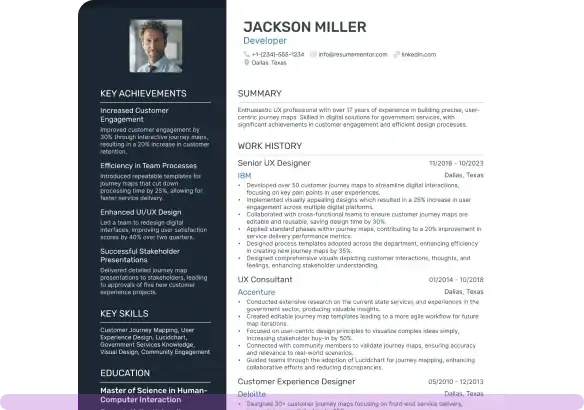Occupational Therapy Assistant Resume Examples

Mar 18, 2025
|
12 min read
Craft an outstanding occupational therapy assistant resume to help you grab opportunities and get a leg-up in your career journey. Learn how to highlight your skills and experience to make your dreams reachable.
Rated by 348 people
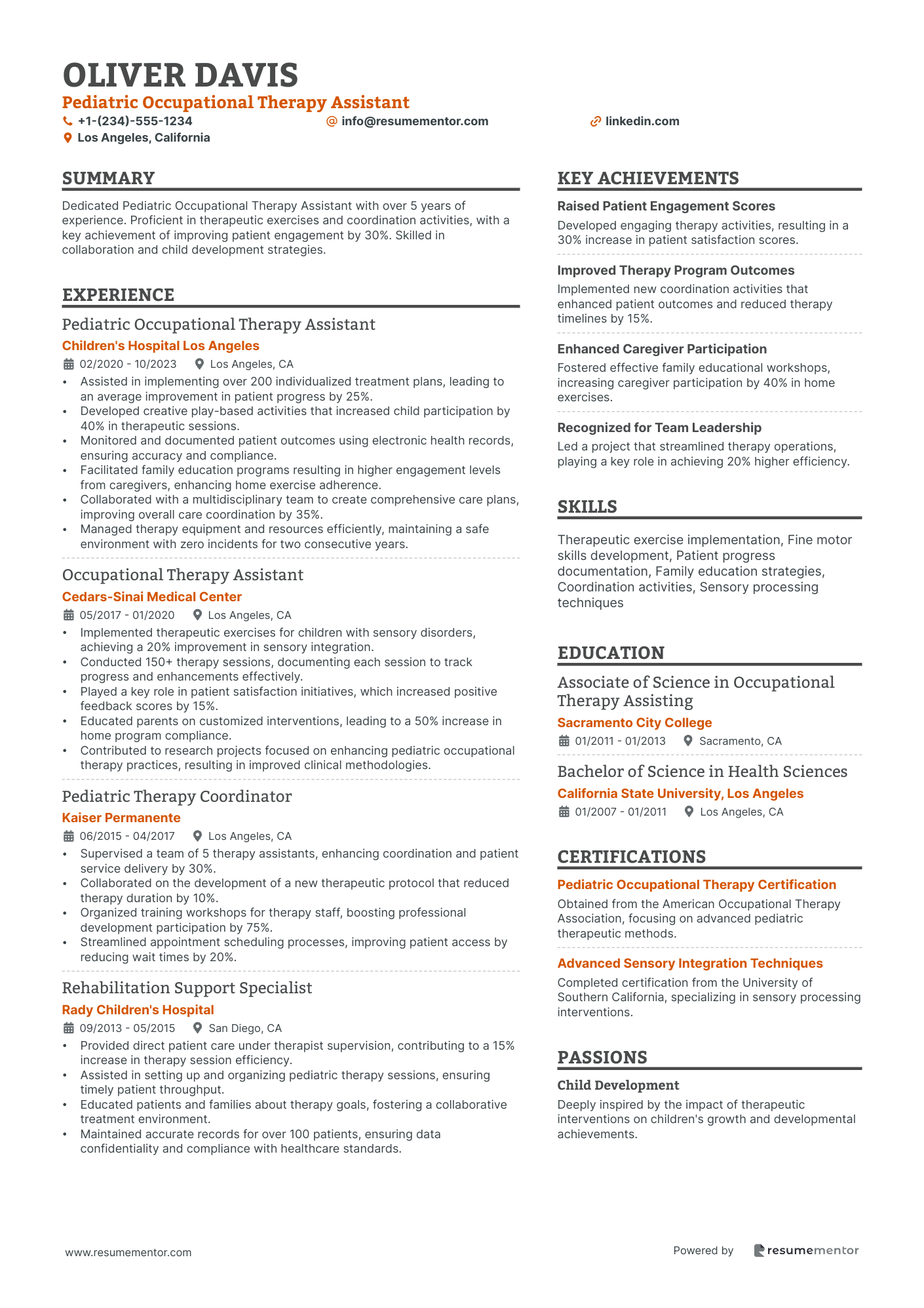
Pediatric Occupational Therapy Assistant
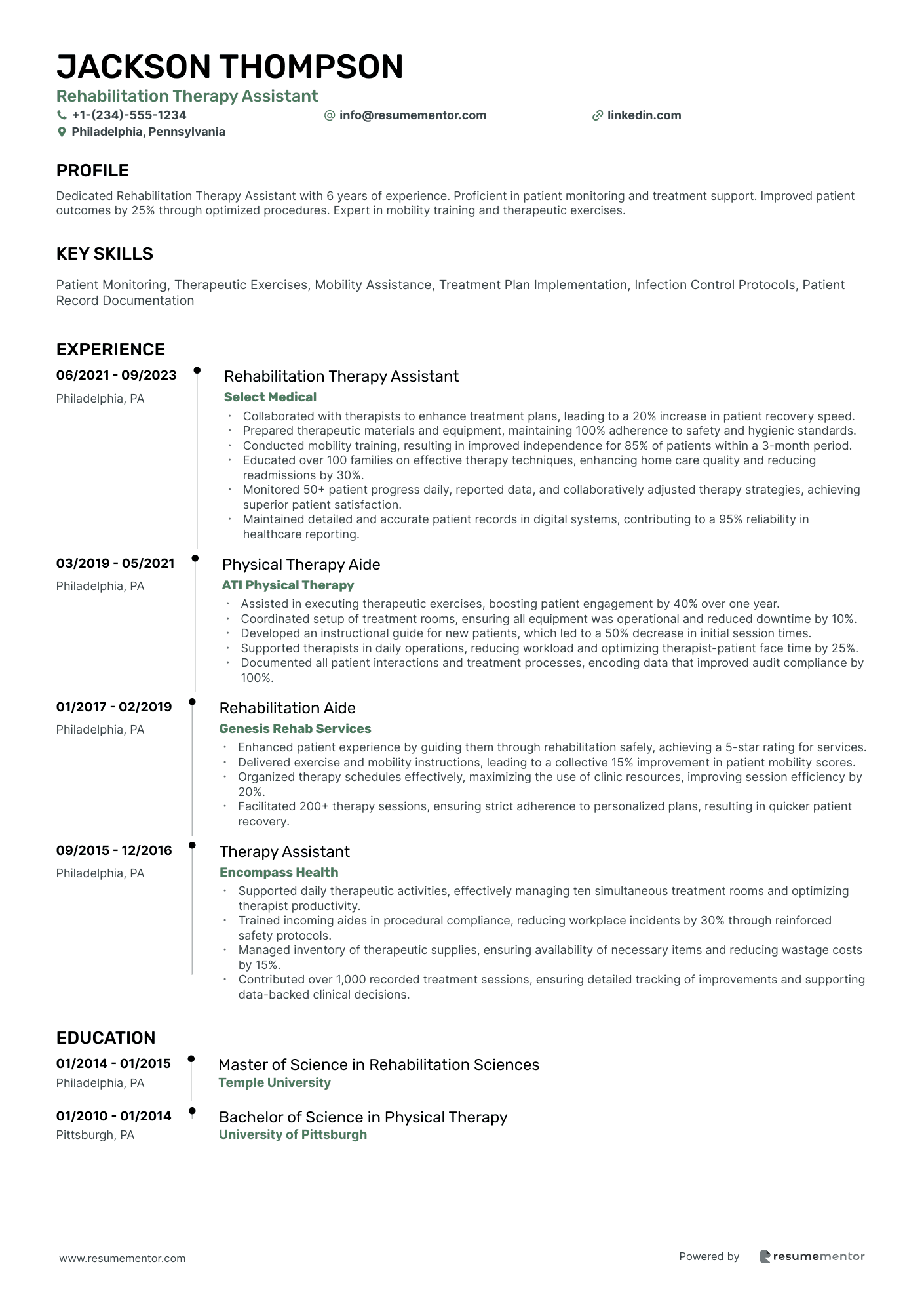
Rehabilitation Therapy Assistant
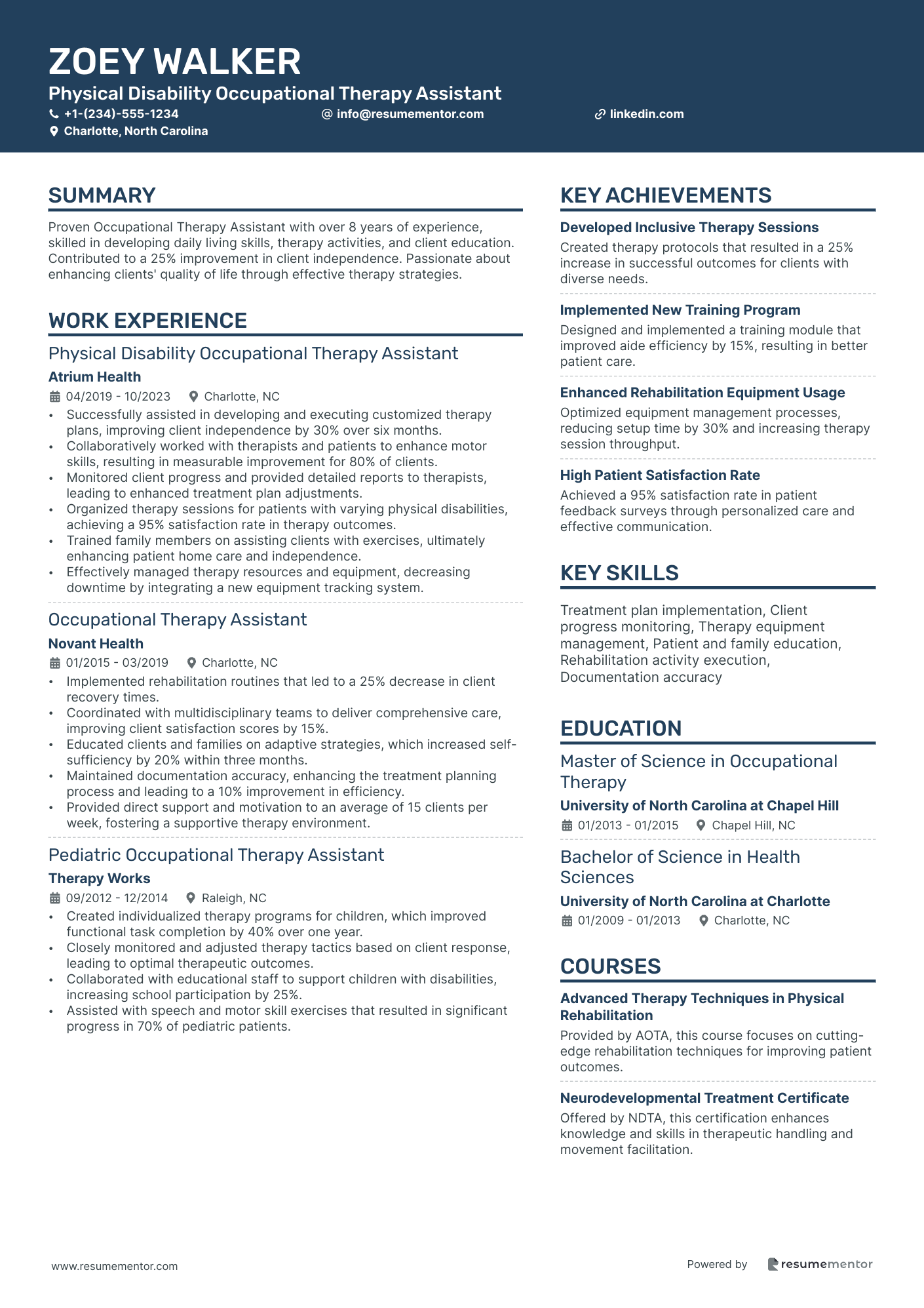
Physical Disability Occupational Therapy Assistant
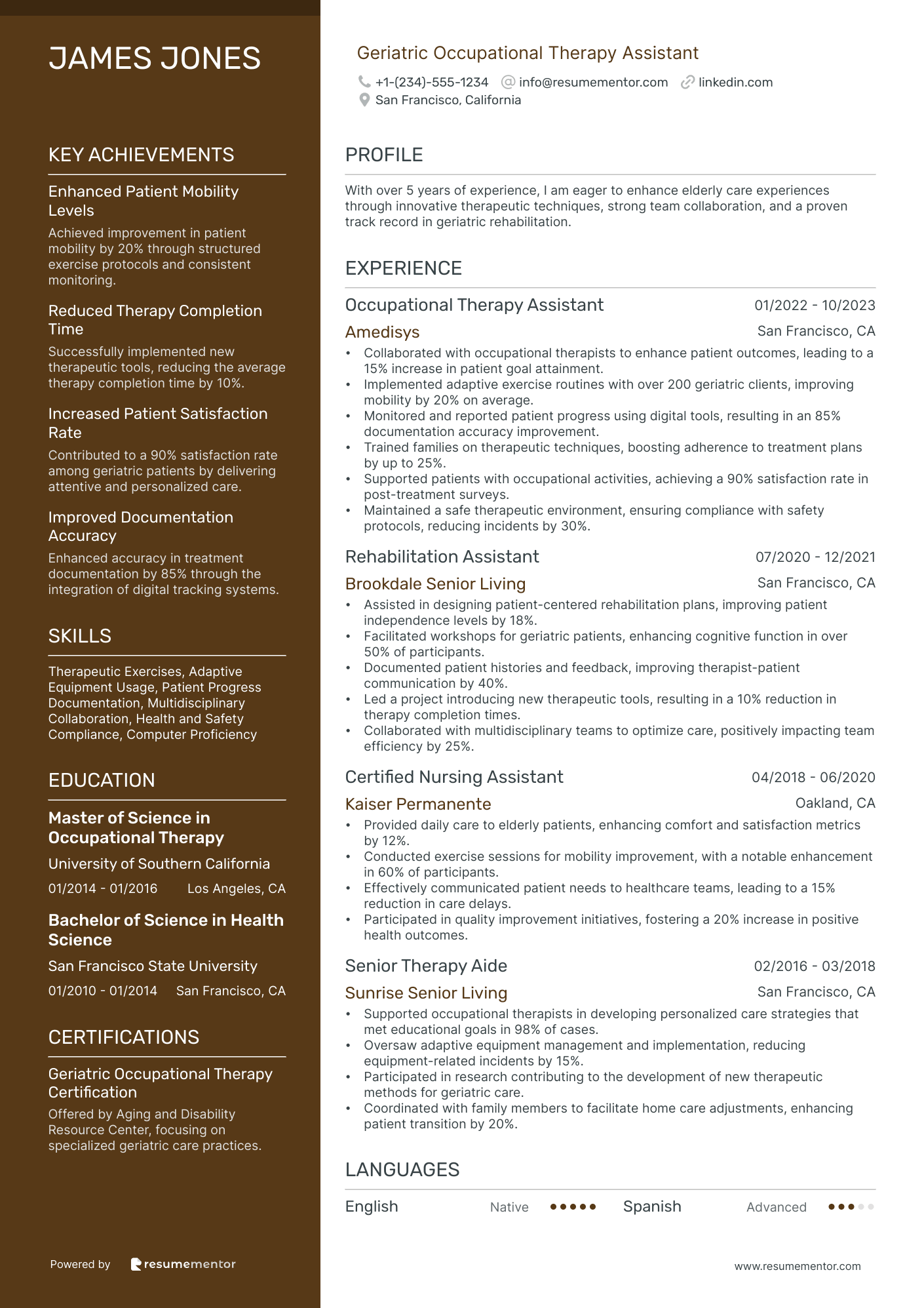
Geriatric Occupational Therapy Assistant
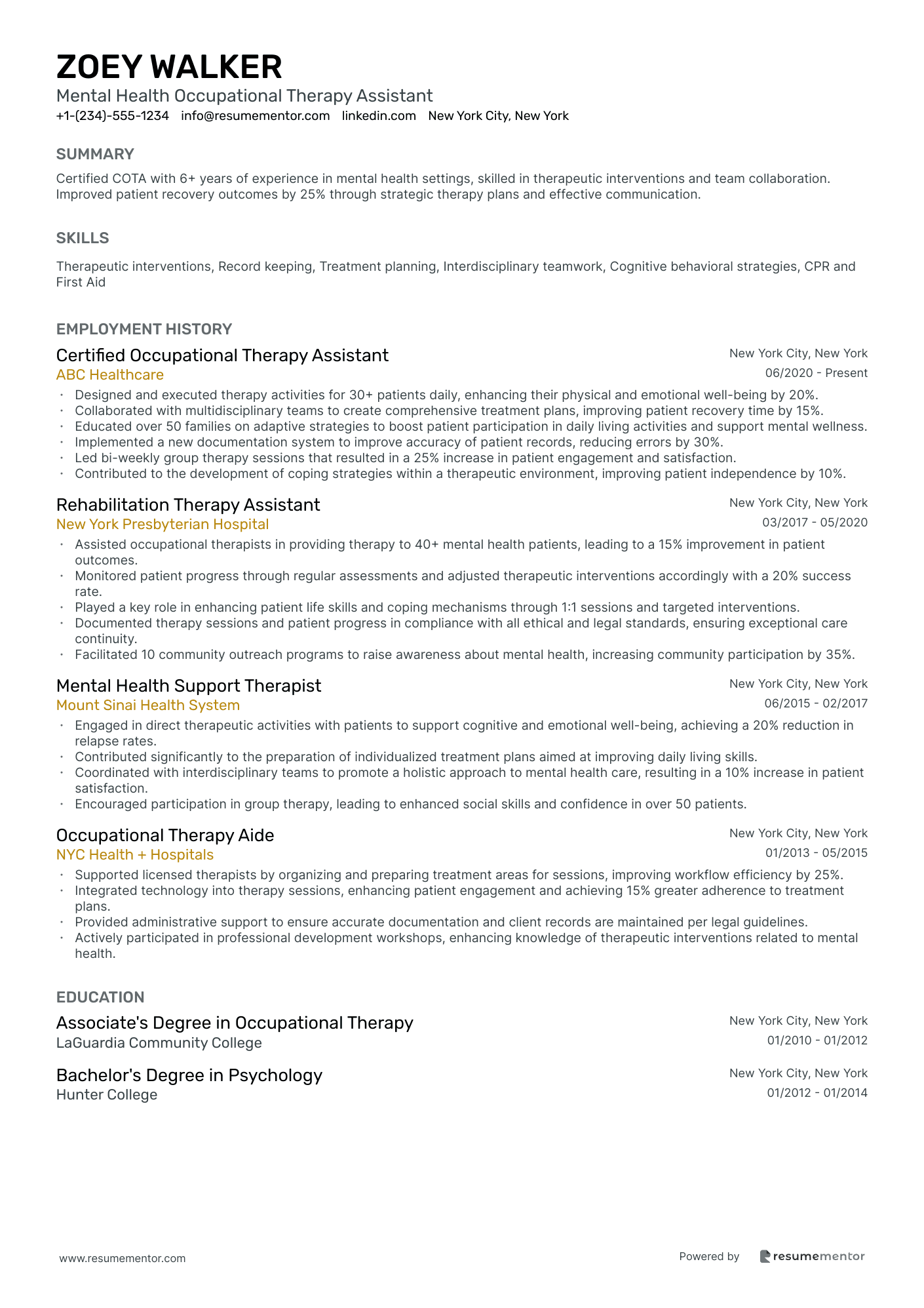
Mental Health Occupational Therapy Assistant
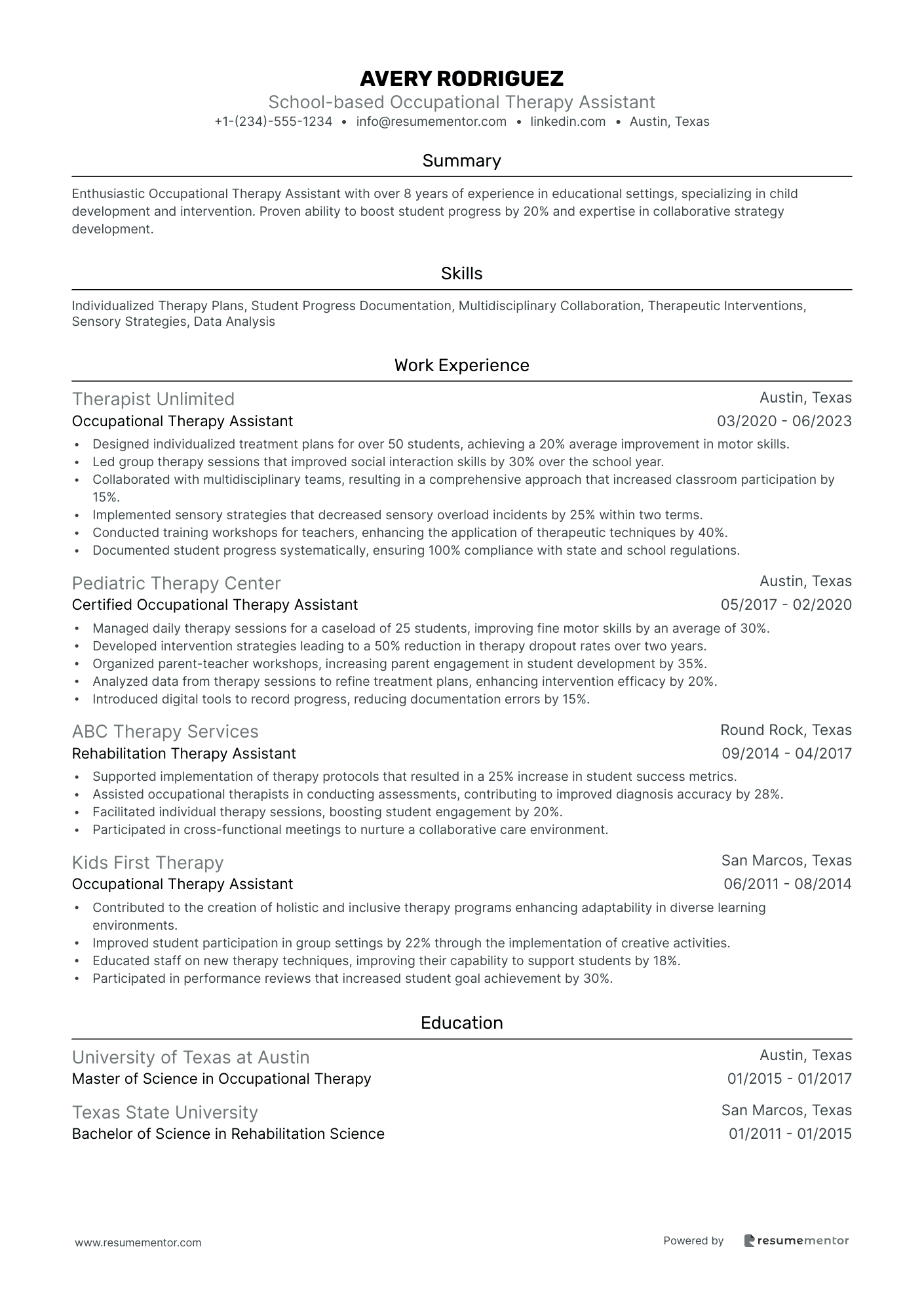
School-based Occupational Therapy Assistant
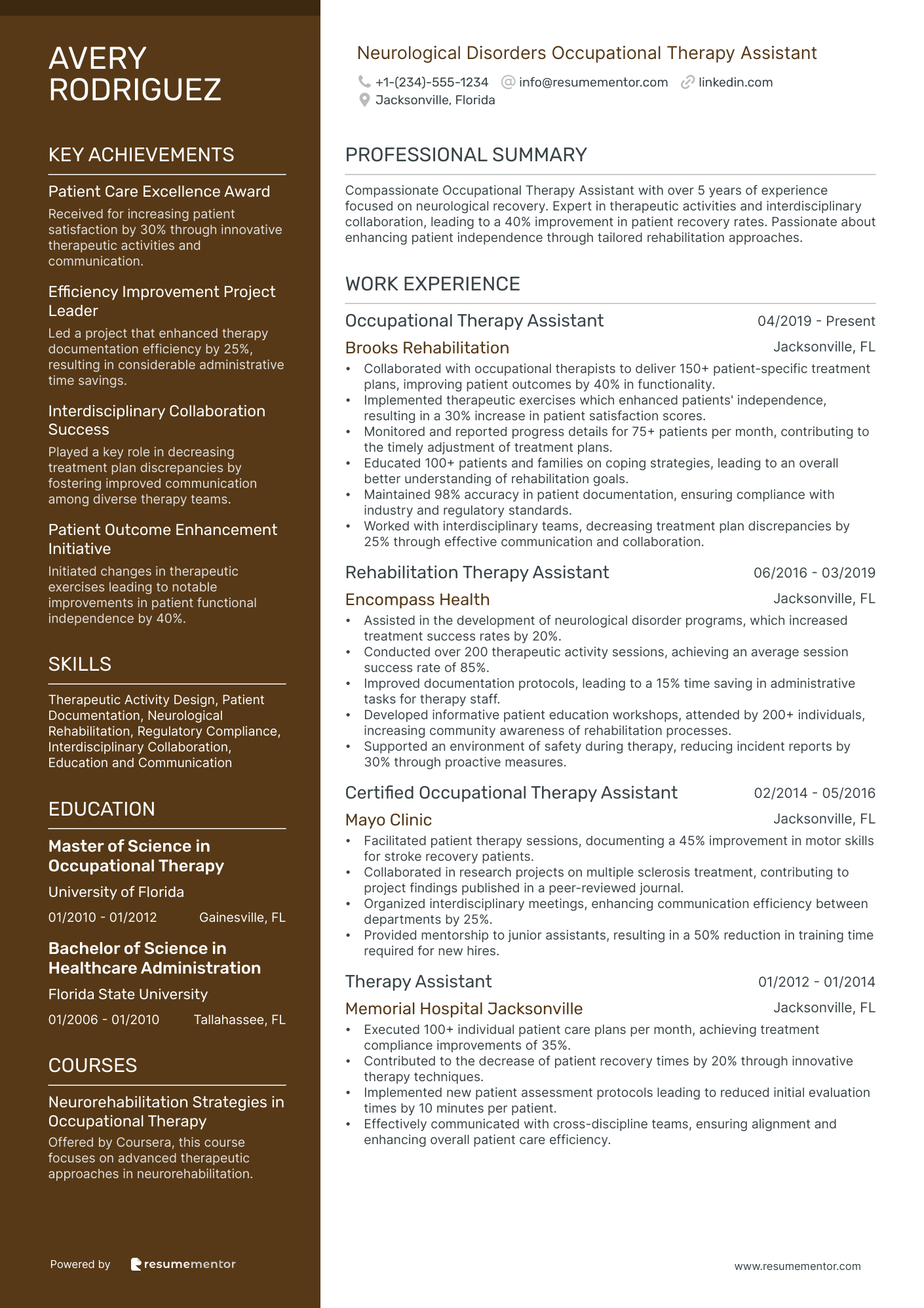
Neurological Disorders Occupational Therapy Assistant
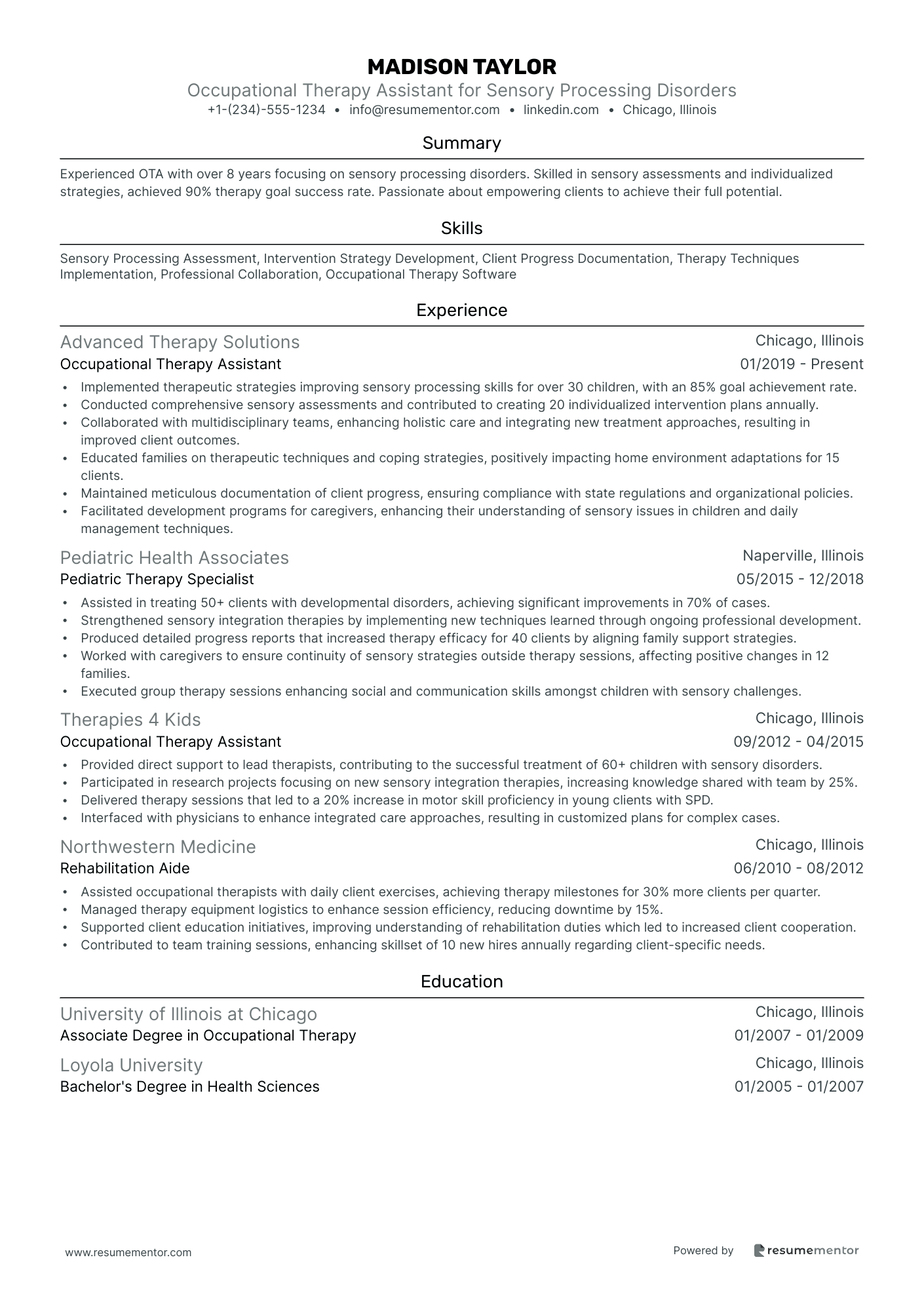
Occupational Therapy Assistant for Sensory Processing Disorders
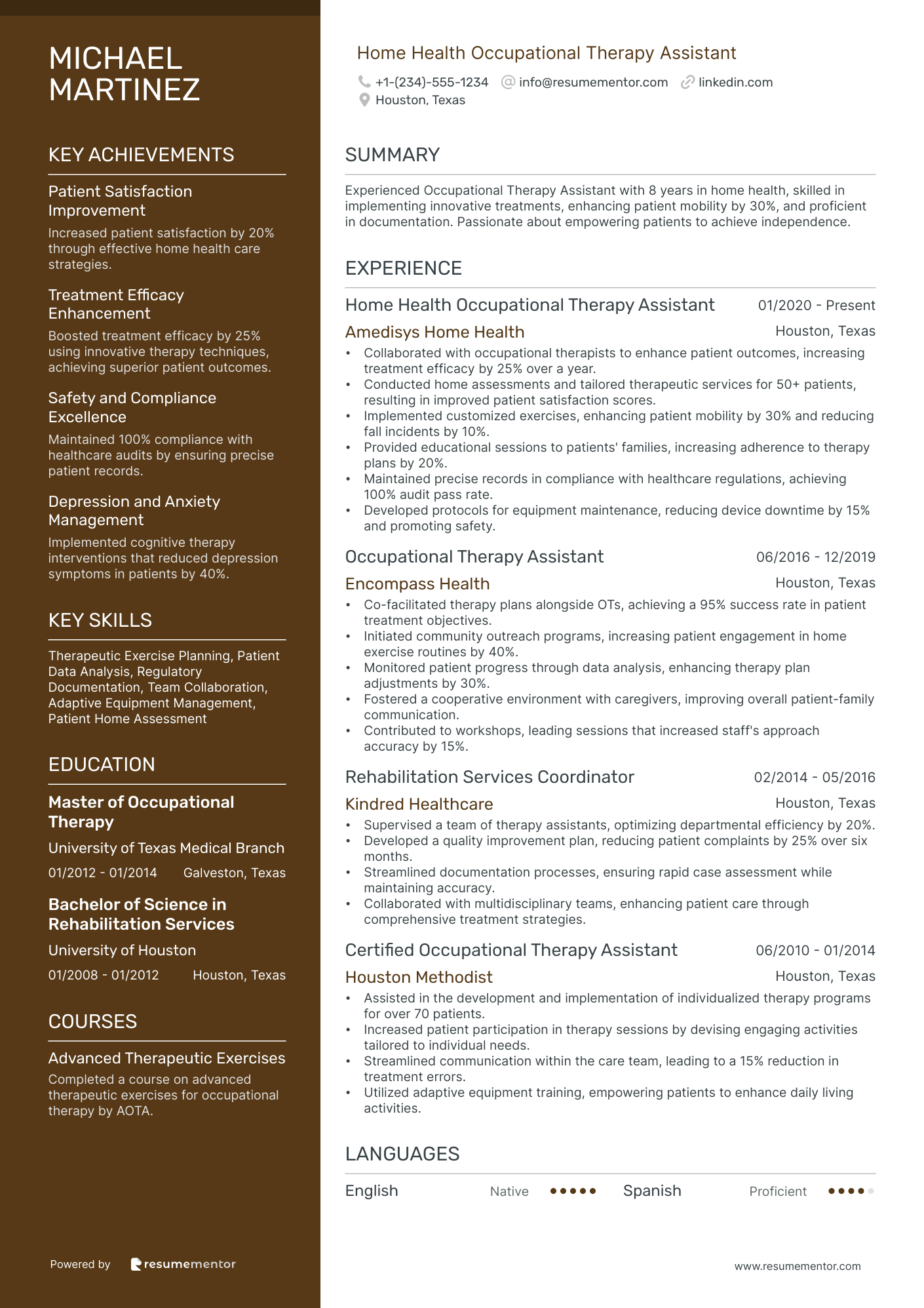
Home Health Occupational Therapy Assistant
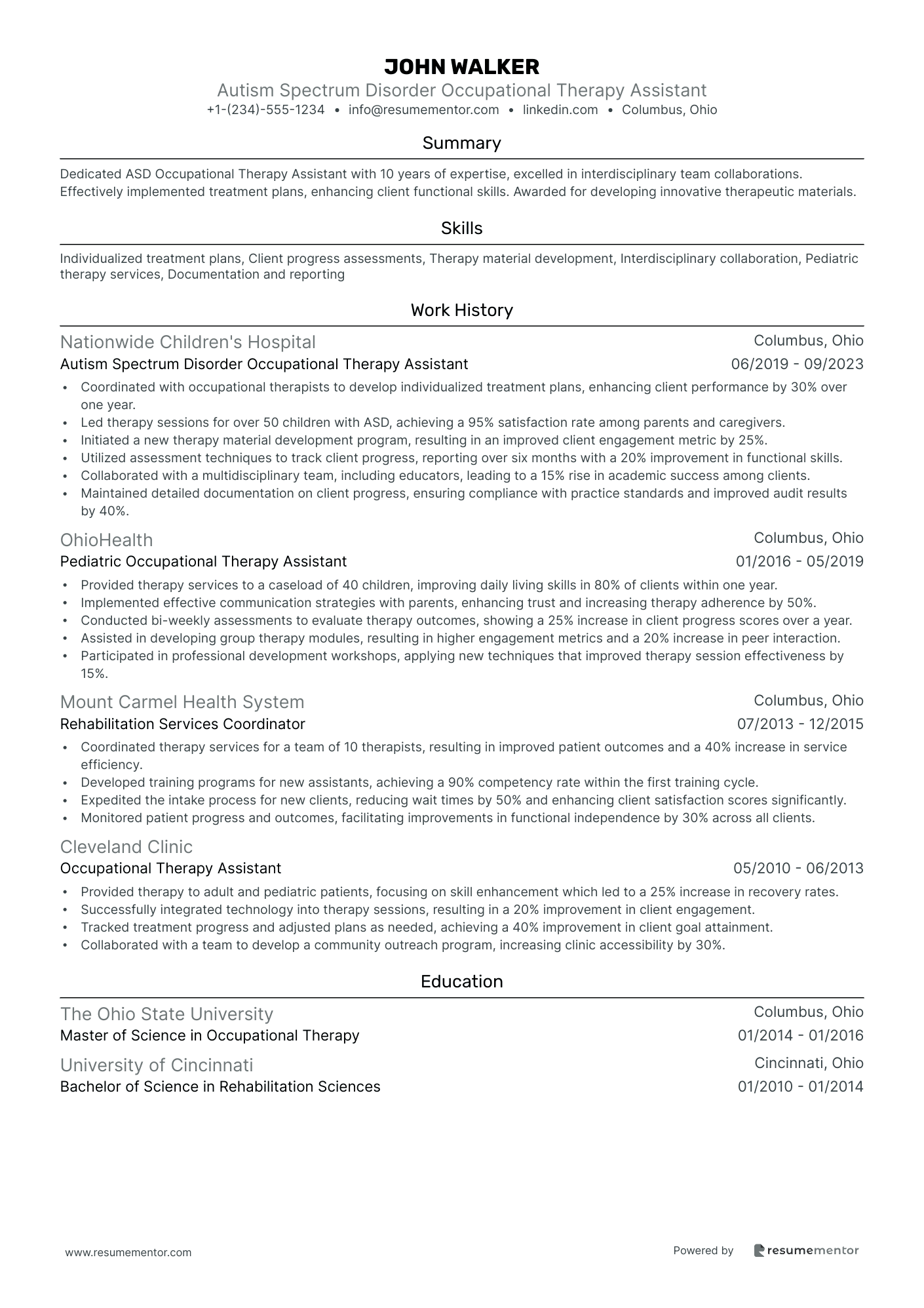
Autism Spectrum Disorder Occupational Therapy Assistant

Pediatric Occupational Therapy Assistant resume sample
- •Assisted in implementing over 200 individualized treatment plans, leading to an average improvement in patient progress by 25%.
- •Developed creative play-based activities that increased child participation by 40% in therapeutic sessions.
- •Monitored and documented patient outcomes using electronic health records, ensuring accuracy and compliance.
- •Facilitated family education programs resulting in higher engagement levels from caregivers, enhancing home exercise adherence.
- •Collaborated with a multidisciplinary team to create comprehensive care plans, improving overall care coordination by 35%.
- •Managed therapy equipment and resources efficiently, maintaining a safe environment with zero incidents for two consecutive years.
- •Implemented therapeutic exercises for children with sensory disorders, achieving a 20% improvement in sensory integration.
- •Conducted 150+ therapy sessions, documenting each session to track progress and enhancements effectively.
- •Played a key role in patient satisfaction initiatives, which increased positive feedback scores by 15%.
- •Educated parents on customized interventions, leading to a 50% increase in home program compliance.
- •Contributed to research projects focused on enhancing pediatric occupational therapy practices, resulting in improved clinical methodologies.
- •Supervised a team of 5 therapy assistants, enhancing coordination and patient service delivery by 30%.
- •Collaborated on the development of a new therapeutic protocol that reduced therapy duration by 10%.
- •Organized training workshops for therapy staff, boosting professional development participation by 75%.
- •Streamlined appointment scheduling processes, improving patient access by reducing wait times by 20%.
- •Provided direct patient care under therapist supervision, contributing to a 15% increase in therapy session efficiency.
- •Assisted in setting up and organizing pediatric therapy sessions, ensuring timely patient throughput.
- •Educated patients and families about therapy goals, fostering a collaborative treatment environment.
- •Maintained accurate records for over 100 patients, ensuring data confidentiality and compliance with healthcare standards.
Rehabilitation Therapy Assistant resume sample
- •Collaborated with therapists to enhance treatment plans, leading to a 20% increase in patient recovery speed.
- •Prepared therapeutic materials and equipment, maintaining 100% adherence to safety and hygienic standards.
- •Conducted mobility training, resulting in improved independence for 85% of patients within a 3-month period.
- •Educated over 100 families on effective therapy techniques, enhancing home care quality and reducing readmissions by 30%.
- •Monitored 50+ patient progress daily, reported data, and collaboratively adjusted therapy strategies, achieving superior patient satisfaction.
- •Maintained detailed and accurate patient records in digital systems, contributing to a 95% reliability in healthcare reporting.
- •Assisted in executing therapeutic exercises, boosting patient engagement by 40% over one year.
- •Coordinated setup of treatment rooms, ensuring all equipment was operational and reduced downtime by 10%.
- •Developed an instructional guide for new patients, which led to a 50% decrease in initial session times.
- •Supported therapists in daily operations, reducing workload and optimizing therapist-patient face time by 25%.
- •Documented all patient interactions and treatment processes, encoding data that improved audit compliance by 100%.
- •Enhanced patient experience by guiding them through rehabilitation safely, achieving a 5-star rating for services.
- •Delivered exercise and mobility instructions, leading to a collective 15% improvement in patient mobility scores.
- •Organized therapy schedules effectively, maximizing the use of clinic resources, improving session efficiency by 20%.
- •Facilitated 200+ therapy sessions, ensuring strict adherence to personalized plans, resulting in quicker patient recovery.
- •Supported daily therapeutic activities, effectively managing ten simultaneous treatment rooms and optimizing therapist productivity.
- •Trained incoming aides in procedural compliance, reducing workplace incidents by 30% through reinforced safety protocols.
- •Managed inventory of therapeutic supplies, ensuring availability of necessary items and reducing wastage costs by 15%.
- •Contributed over 1,000 recorded treatment sessions, ensuring detailed tracking of improvements and supporting data-backed clinical decisions.
Physical Disability Occupational Therapy Assistant resume sample
- •Successfully assisted in developing and executing customized therapy plans, improving client independence by 30% over six months.
- •Collaboratively worked with therapists and patients to enhance motor skills, resulting in measurable improvement for 80% of clients.
- •Monitored client progress and provided detailed reports to therapists, leading to enhanced treatment plan adjustments.
- •Organized therapy sessions for patients with varying physical disabilities, achieving a 95% satisfaction rate in therapy outcomes.
- •Trained family members on assisting clients with exercises, ultimately enhancing patient home care and independence.
- •Effectively managed therapy resources and equipment, decreasing downtime by integrating a new equipment tracking system.
- •Implemented rehabilitation routines that led to a 25% decrease in client recovery times.
- •Coordinated with multidisciplinary teams to deliver comprehensive care, improving client satisfaction scores by 15%.
- •Educated clients and families on adaptive strategies, which increased self-sufficiency by 20% within three months.
- •Maintained documentation accuracy, enhancing the treatment planning process and leading to a 10% improvement in efficiency.
- •Provided direct support and motivation to an average of 15 clients per week, fostering a supportive therapy environment.
- •Created individualized therapy programs for children, which improved functional task completion by 40% over one year.
- •Closely monitored and adjusted therapy tactics based on client response, leading to optimal therapeutic outcomes.
- •Collaborated with educational staff to support children with disabilities, increasing school participation by 25%.
- •Assisted with speech and motor skill exercises that resulted in significant progress in 70% of pediatric patients.
- •Aided therapy sessions by preparing and managing materials, allowing therapists to increase patient appointments by 10%.
- •Conducted patient intake assessments and maintained detailed records, streamlining the therapy planning process.
- •Supported therapists in training new aides, enhancing team efficiency and patient care continuity.
- •Facilitated therapy exercises for patients, improving patient satisfaction scores by focusing on individual needs.
Geriatric Occupational Therapy Assistant resume sample
- •Collaborated with occupational therapists to enhance patient outcomes, leading to a 15% increase in patient goal attainment.
- •Implemented adaptive exercise routines with over 200 geriatric clients, improving mobility by 20% on average.
- •Monitored and reported patient progress using digital tools, resulting in an 85% documentation accuracy improvement.
- •Trained families on therapeutic techniques, boosting adherence to treatment plans by up to 25%.
- •Supported patients with occupational activities, achieving a 90% satisfaction rate in post-treatment surveys.
- •Maintained a safe therapeutic environment, ensuring compliance with safety protocols, reducing incidents by 30%.
- •Assisted in designing patient-centered rehabilitation plans, improving patient independence levels by 18%.
- •Facilitated workshops for geriatric patients, enhancing cognitive function in over 50% of participants.
- •Documented patient histories and feedback, improving therapist-patient communication by 40%.
- •Led a project introducing new therapeutic tools, resulting in a 10% reduction in therapy completion times.
- •Collaborated with multidisciplinary teams to optimize care, positively impacting team efficiency by 25%.
- •Provided daily care to elderly patients, enhancing comfort and satisfaction metrics by 12%.
- •Conducted exercise sessions for mobility improvement, with a notable enhancement in 60% of participants.
- •Effectively communicated patient needs to healthcare teams, leading to a 15% reduction in care delays.
- •Participated in quality improvement initiatives, fostering a 20% increase in positive health outcomes.
- •Supported occupational therapists in developing personalized care strategies that met educational goals in 98% of cases.
- •Oversaw adaptive equipment management and implementation, reducing equipment-related incidents by 15%.
- •Participated in research contributing to the development of new therapeutic methods for geriatric care.
- •Coordinated with family members to facilitate home care adjustments, enhancing patient transition by 20%.
Mental Health Occupational Therapy Assistant resume sample
- •Designed and executed therapy activities for 30+ patients daily, enhancing their physical and emotional well-being by 20%.
- •Collaborated with multidisciplinary teams to create comprehensive treatment plans, improving patient recovery time by 15%.
- •Educated over 50 families on adaptive strategies to boost patient participation in daily living activities and support mental wellness.
- •Implemented a new documentation system to improve accuracy of patient records, reducing errors by 30%.
- •Led bi-weekly group therapy sessions that resulted in a 25% increase in patient engagement and satisfaction.
- •Contributed to the development of coping strategies within a therapeutic environment, improving patient independence by 10%.
- •Assisted occupational therapists in providing therapy to 40+ mental health patients, leading to a 15% improvement in patient outcomes.
- •Monitored patient progress through regular assessments and adjusted therapeutic interventions accordingly with a 20% success rate.
- •Played a key role in enhancing patient life skills and coping mechanisms through 1:1 sessions and targeted interventions.
- •Documented therapy sessions and patient progress in compliance with all ethical and legal standards, ensuring exceptional care continuity.
- •Facilitated 10 community outreach programs to raise awareness about mental health, increasing community participation by 35%.
- •Engaged in direct therapeutic activities with patients to support cognitive and emotional well-being, achieving a 20% reduction in relapse rates.
- •Contributed significantly to the preparation of individualized treatment plans aimed at improving daily living skills.
- •Coordinated with interdisciplinary teams to promote a holistic approach to mental health care, resulting in a 10% increase in patient satisfaction.
- •Encouraged participation in group therapy, leading to enhanced social skills and confidence in over 50 patients.
- •Supported licensed therapists by organizing and preparing treatment areas for sessions, improving workflow efficiency by 25%.
- •Integrated technology into therapy sessions, enhancing patient engagement and achieving 15% greater adherence to treatment plans.
- •Provided administrative support to ensure accurate documentation and client records are maintained per legal guidelines.
- •Actively participated in professional development workshops, enhancing knowledge of therapeutic interventions related to mental health.
School-based Occupational Therapy Assistant resume sample
- •Designed individualized treatment plans for over 50 students, achieving a 20% average improvement in motor skills.
- •Led group therapy sessions that improved social interaction skills by 30% over the school year.
- •Collaborated with multidisciplinary teams, resulting in a comprehensive approach that increased classroom participation by 15%.
- •Implemented sensory strategies that decreased sensory overload incidents by 25% within two terms.
- •Conducted training workshops for teachers, enhancing the application of therapeutic techniques by 40%.
- •Documented student progress systematically, ensuring 100% compliance with state and school regulations.
- •Managed daily therapy sessions for a caseload of 25 students, improving fine motor skills by an average of 30%.
- •Developed intervention strategies leading to a 50% reduction in therapy dropout rates over two years.
- •Organized parent-teacher workshops, increasing parent engagement in student development by 35%.
- •Analyzed data from therapy sessions to refine treatment plans, enhancing intervention efficacy by 20%.
- •Introduced digital tools to record progress, reducing documentation errors by 15%.
- •Supported implementation of therapy protocols that resulted in a 25% increase in student success metrics.
- •Assisted occupational therapists in conducting assessments, contributing to improved diagnosis accuracy by 28%.
- •Facilitated individual therapy sessions, boosting student engagement by 20%.
- •Participated in cross-functional meetings to nurture a collaborative care environment.
- •Contributed to the creation of holistic and inclusive therapy programs enhancing adaptability in diverse learning environments.
- •Improved student participation in group settings by 22% through the implementation of creative activities.
- •Educated staff on new therapy techniques, improving their capability to support students by 18%.
- •Participated in performance reviews that increased student goal achievement by 30%.
Neurological Disorders Occupational Therapy Assistant resume sample
- •Collaborated with occupational therapists to deliver 150+ patient-specific treatment plans, improving patient outcomes by 40% in functionality.
- •Implemented therapeutic exercises which enhanced patients' independence, resulting in a 30% increase in patient satisfaction scores.
- •Monitored and reported progress details for 75+ patients per month, contributing to the timely adjustment of treatment plans.
- •Educated 100+ patients and families on coping strategies, leading to an overall better understanding of rehabilitation goals.
- •Maintained 98% accuracy in patient documentation, ensuring compliance with industry and regulatory standards.
- •Worked with interdisciplinary teams, decreasing treatment plan discrepancies by 25% through effective communication and collaboration.
- •Assisted in the development of neurological disorder programs, which increased treatment success rates by 20%.
- •Conducted over 200 therapeutic activity sessions, achieving an average session success rate of 85%.
- •Improved documentation protocols, leading to a 15% time saving in administrative tasks for therapy staff.
- •Developed informative patient education workshops, attended by 200+ individuals, increasing community awareness of rehabilitation processes.
- •Supported an environment of safety during therapy, reducing incident reports by 30% through proactive measures.
- •Facilitated patient therapy sessions, documenting a 45% improvement in motor skills for stroke recovery patients.
- •Collaborated in research projects on multiple sclerosis treatment, contributing to project findings published in a peer-reviewed journal.
- •Organized interdisciplinary meetings, enhancing communication efficiency between departments by 25%.
- •Provided mentorship to junior assistants, resulting in a 50% reduction in training time required for new hires.
- •Executed 100+ individual patient care plans per month, achieving treatment compliance improvements of 35%.
- •Contributed to the decrease of patient recovery times by 20% through innovative therapy techniques.
- •Implemented new patient assessment protocols leading to reduced initial evaluation times by 10 minutes per patient.
- •Effectively communicated with cross-discipline teams, ensuring alignment and enhancing overall patient care efficiency.
Occupational Therapy Assistant for Sensory Processing Disorders resume sample
- •Implemented therapeutic strategies improving sensory processing skills for over 30 children, with an 85% goal achievement rate.
- •Conducted comprehensive sensory assessments and contributed to creating 20 individualized intervention plans annually.
- •Collaborated with multidisciplinary teams, enhancing holistic care and integrating new treatment approaches, resulting in improved client outcomes.
- •Educated families on therapeutic techniques and coping strategies, positively impacting home environment adaptations for 15 clients.
- •Maintained meticulous documentation of client progress, ensuring compliance with state regulations and organizational policies.
- •Facilitated development programs for caregivers, enhancing their understanding of sensory issues in children and daily management techniques.
- •Assisted in treating 50+ clients with developmental disorders, achieving significant improvements in 70% of cases.
- •Strengthened sensory integration therapies by implementing new techniques learned through ongoing professional development.
- •Produced detailed progress reports that increased therapy efficacy for 40 clients by aligning family support strategies.
- •Worked with caregivers to ensure continuity of sensory strategies outside therapy sessions, affecting positive changes in 12 families.
- •Executed group therapy sessions enhancing social and communication skills amongst children with sensory challenges.
- •Provided direct support to lead therapists, contributing to the successful treatment of 60+ children with sensory disorders.
- •Participated in research projects focusing on new sensory integration therapies, increasing knowledge shared with team by 25%.
- •Delivered therapy sessions that led to a 20% increase in motor skill proficiency in young clients with SPD.
- •Interfaced with physicians to enhance integrated care approaches, resulting in customized plans for complex cases.
- •Assisted occupational therapists with daily client exercises, achieving therapy milestones for 30% more clients per quarter.
- •Managed therapy equipment logistics to enhance session efficiency, reducing downtime by 15%.
- •Supported client education initiatives, improving understanding of rehabilitation duties which led to increased client cooperation.
- •Contributed to team training sessions, enhancing skillset of 10 new hires annually regarding client-specific needs.
Home Health Occupational Therapy Assistant resume sample
- •Collaborated with occupational therapists to enhance patient outcomes, increasing treatment efficacy by 25% over a year.
- •Conducted home assessments and tailored therapeutic services for 50+ patients, resulting in improved patient satisfaction scores.
- •Implemented customized exercises, enhancing patient mobility by 30% and reducing fall incidents by 10%.
- •Provided educational sessions to patients' families, increasing adherence to therapy plans by 20%.
- •Maintained precise records in compliance with healthcare regulations, achieving 100% audit pass rate.
- •Developed protocols for equipment maintenance, reducing device downtime by 15% and promoting safety.
- •Co-facilitated therapy plans alongside OTs, achieving a 95% success rate in patient treatment objectives.
- •Initiated community outreach programs, increasing patient engagement in home exercise routines by 40%.
- •Monitored patient progress through data analysis, enhancing therapy plan adjustments by 30%.
- •Fostered a cooperative environment with caregivers, improving overall patient-family communication.
- •Contributed to workshops, leading sessions that increased staff's approach accuracy by 15%.
- •Supervised a team of therapy assistants, optimizing departmental efficiency by 20%.
- •Developed a quality improvement plan, reducing patient complaints by 25% over six months.
- •Streamlined documentation processes, ensuring rapid case assessment while maintaining accuracy.
- •Collaborated with multidisciplinary teams, enhancing patient care through comprehensive treatment strategies.
- •Assisted in the development and implementation of individualized therapy programs for over 70 patients.
- •Increased patient participation in therapy sessions by devising engaging activities tailored to individual needs.
- •Streamlined communication within the care team, leading to a 15% reduction in treatment errors.
- •Utilized adaptive equipment training, empowering patients to enhance daily living activities.
Autism Spectrum Disorder Occupational Therapy Assistant resume sample
- •Coordinated with occupational therapists to develop individualized treatment plans, enhancing client performance by 30% over one year.
- •Led therapy sessions for over 50 children with ASD, achieving a 95% satisfaction rate among parents and caregivers.
- •Initiated a new therapy material development program, resulting in an improved client engagement metric by 25%.
- •Utilized assessment techniques to track client progress, reporting over six months with a 20% improvement in functional skills.
- •Collaborated with a multidisciplinary team, including educators, leading to a 15% rise in academic success among clients.
- •Maintained detailed documentation on client progress, ensuring compliance with practice standards and improved audit results by 40%.
- •Provided therapy services to a caseload of 40 children, improving daily living skills in 80% of clients within one year.
- •Implemented effective communication strategies with parents, enhancing trust and increasing therapy adherence by 50%.
- •Conducted bi-weekly assessments to evaluate therapy outcomes, showing a 25% increase in client progress scores over a year.
- •Assisted in developing group therapy modules, resulting in higher engagement metrics and a 20% increase in peer interaction.
- •Participated in professional development workshops, applying new techniques that improved therapy session effectiveness by 15%.
- •Coordinated therapy services for a team of 10 therapists, resulting in improved patient outcomes and a 40% increase in service efficiency.
- •Developed training programs for new assistants, achieving a 90% competency rate within the first training cycle.
- •Expedited the intake process for new clients, reducing wait times by 50% and enhancing client satisfaction scores significantly.
- •Monitored patient progress and outcomes, facilitating improvements in functional independence by 30% across all clients.
- •Provided therapy to adult and pediatric patients, focusing on skill enhancement which led to a 25% increase in recovery rates.
- •Successfully integrated technology into therapy sessions, resulting in a 20% improvement in client engagement.
- •Tracked treatment progress and adjusted plans as needed, achieving a 40% improvement in client goal attainment.
- •Collaborated with a team to develop a community outreach program, increasing clinic accessibility by 30%.
As an occupational therapy assistant, you're the helping hands that guide patients toward their goals. Just like your work requires balance and care, a well-crafted resume is essential to succeed in your job search. Transforming your hands-on skills into a compelling resume can feel challenging, but connecting effectively with employers is just as important as connecting with patients. Highlighting your therapeutic expertise and daily contributions is key to standing out.
Think of your resume as more than just a list of jobs—it's your personal statement of dedication and skill in occupational therapy. With the right approach, you can create a document that truly reflects your commitment to helping others thrive. Using a resume template can make this process smoother, keeping your information organized and appealing. These templates save time and provide a solid framework to showcase your abilities as an occupational therapy assistant.
Facing the job search shouldn't feel overwhelming. A good resume framework helps you demonstrate how your calming presence and therapeutic skills can benefit any healthcare team. By capturing your passion for helping people, your resume will guide you confidently toward your next opportunity. This guide will show you how to express your abilities and aspirations effectively, paving the way for the next chapter in your professional journey.
Key Takeaways
- A well-crafted resume is essential for occupational therapy assistants, transforming hands-on skills into a compelling narrative that connects effectively with employers and showcases therapeutic expertise.
- Using a resume template helps in organizing information, making the resume more appealing and reflective of your commitment to patient care and thriving in your career.
- The resume should focus on highlighting clinical skills, empathy, and contributions to healthcare teams, emphasizing your role in enhancing patients' daily lives and making you an indispensable asset to any team.
- Including sections like Volunteer Experience, Languages Spoken, or Professional Affiliations provides a comprehensive picture of your dedication, skill set, and ability to connect with diverse populations.
- Choosing the right resume format and including sections such as quantifiable achievements, licenses, certifications, education, and additional skills ensures effective communication of your expertise and readiness for the role.
What to focus on when writing your occupational therapy assistant resume
Your occupational therapy assistant resume should clearly convey your capacity to enhance patients' daily lives through supportive care. By highlighting your clinical skills and empathy, you create a compelling narrative of your attention to detail—qualities that recruiters are actively seeking. Your experience and skills should contribute positively to healthcare teams and client outcomes, making you an indispensable asset they desire.
How to structure your occupational therapy assistant resume
- Contact Information—Ensure this section includes your full name, phone number, email address, and LinkedIn profile if applicable. Accurate and up-to-date contact information is crucial, as it enables the recruiter to easily reach out to you for interviews or further inquiries.
- Professional Summary—Craft a compelling paragraph that encapsulates your experience, skills, and ambitions as an occupational therapy assistant. This opening statement sets the stage for your resume by briefly illustrating your value to the potential employer and outlining your professional journey.
- Experience—Your experience section should narrate how you have effectively supported occupational therapists in delivering treatment plans and interacting with patients. Highlight specific populations, such as elderly or pediatric patients, to show your adaptability and targeted expertise, giving the recruiter a clearer view of your capabilities.
- Skills—This section should logically extend from your experience, with a focus on patient care abilities, therapy techniques, and equipment familiarity. By noting expertise with electronic health records systems, you underscore your technical proficiency, which is highly valued in modern healthcare environments.
- Education—Detail the educational foundations that have equipped you for this role. Include your degree, certification as an occupational therapy assistant, and any additional courses or training that keep you informed and competitive within your field. This solid educational base strengthens your professional profile.
- Licenses and Certifications—Detail your Occupational Therapy Assistant license and any complementing certifications, such as CPR or first aid. These credentials not only validate your qualifications but also highlight your readiness for immediate contribution to a new team.
To make your resume even more distinctive, include sections like Volunteer Experience, Languages Spoken, or Professional Affiliations, offering a comprehensive picture of your dedication and skill set. Now, let’s explore each resume section in more detail to ensure your format is both effective and impactful.
Which resume format to choose
As an occupational therapy assistant, picking the right resume format can really boost your chances of landing an interview. With a chronological layout, you can highlight your steady career progression in the healthcare field, which reassures employers about your experience and reliability. When it comes to fonts, opt for modern choices like Raleway, Lato, or Montserrat, which offer a professional appearance and improve readability, making it easy for hiring managers to focus on your skills and accomplishments. Always save your resume as a PDF to ensure that your layout and design remain consistent across all devices and platforms, so it looks professional no matter where it’s viewed. Keeping margins at around one inch gives your resume a clean appearance, preventing the page from feeling cluttered and allowing your qualifications and experience to be the focus. By considering these details, your resume will effectively communicate your expertise and readiness for the role.
How to write a quantifiable resume experience section
Your occupational therapy assistant experience section plays a crucial role in highlighting your skills and achievements in a way that’s tailored to the job you're applying for. Begin with your most recent role and work backward, covering up to 10-15 years of relevant experience. Make sure your job titles and descriptions align with the job ad, focusing on skills that match what the employer is looking for. Each bullet point should showcase a quantifiable achievement to clearly demonstrate your impact. Use strong action verbs like “facilitated,” “implemented,” and “enhanced” to vividly convey your contributions and the difference you've made.
Here's an engaging example of an occupational therapy assistant resume experience section:
- •Facilitated over 200 successful patient rehabilitation plans, increasing patient satisfaction scores by 30%.
- •Implemented new therapeutic techniques that reduced recovery time by 20% for patients post-surgery.
- •Trained and coordinated with a team of 10 aides, boosting team efficiency by 25%.
- •Enhanced community outreach programs, leading to a 40% growth in patient referrals.
This experience section effectively conveys your professional story by tying together your achievements and skills in a natural way. The use of industry-specific action words not only aligns with the job description but also paints a clear picture of your expertise. These structured sentences flow smoothly into each other, emphasizing your contributions while making your unique impact easy to understand. By presenting your experience in this coherent manner, you’re much more likely to capture the attention of hiring managers.
Project-Focused resume experience section
A project-focused resume experience section for an occupational therapy assistant should clearly highlight the projects where you made a significant impact. Start each bullet point with strong action verbs to draw attention to your achievements and create a cohesive narrative. Focus on describing your role, the actions you took, and the positive outcomes, showcasing how your efforts directly contributed to the success of the projects.
Incorporate quantitative or qualitative results to add depth and substance to your accomplishments. Tailor your descriptions to emphasize the skills and attributes the employer values, ensuring a strong match with their needs. Here is an example structured in JSON format:
Occupational Therapy Assistant
Sunnydale Healthcare Center
June 2020 - August 2023
- Helped design treatment plans that improved patient mobility by 30%, demonstrating my commitment to patient progress.
- Collaborated with a team to create a new stroke recovery method, which significantly improved patient outcomes and highlighted my teamwork skills.
- Streamlined patient documentation processes, reducing administrative tasks by 20% and allowing more time for patient care.
- Led weekly sessions to gather patient feedback, actively using insights to enhance treatment approaches and boost satisfaction scores.
Responsibility-Focused resume experience section
A responsibility-focused occupational therapy assistant resume experience section should effectively highlight your role in patient care, teamwork, and efficient task management. Begin by detailing how your responsibilities and achievements have supported patient progress and facilitated the work of occupational therapists. Highlight any special skills or expertise you have, such as proficiency in certain therapy techniques or successful interactions with specific patient populations, to make your experiences stand out. Use active language and include measurable outcomes to provide a clear picture of your impact.
When presenting your experience, connect your responsibilities to tangible results to demonstrate your effectiveness. Clearly indicate your employment dates, job title, and the organization where you worked, followed by bullet points that illustrate the key duties and accomplishments of your role. Each bullet should show a different facet of your work, enabling employers to easily understand how your experience aligns with their needs, turning your resume into a compelling narrative of your professional journey.
Occupational Therapy Assistant
Healthwise Rehabilitation Center
June 2019 - Present
- Assisted occupational therapists in providing therapeutic activities to over 30 patients weekly, ensuring personalized care.
- Collaborated closely with healthcare teams to craft tailored patient care plans, resulting in a 20% improvement in patient progress.
- Monitored patient progress and documented changes, facilitating clear communication with therapists for optimal outcomes.
- Managed therapy equipment efficiently, leading to a 15% improvement in preparation time for therapy sessions.
Industry-Specific Focus resume experience section
A pediatric-focused occupational therapy assistant resume experience section should emphasize your skills in patient care and therapeutic activities. Begin by stating your job title and workplace, ensuring that the dates of employment are clearly indicated. This helps set the context for your experience. Using strong action verbs, describe your responsibilities and highlight your proactive approach to your role. Each bullet point should explain not only what you did but also how you applied your skills and the positive outcomes you achieved.
It’s essential to spotlight accomplishments that demonstrate your expertise in therapy practices and how you interact with patients. Include any programs you helped develop or instances where you made significant contributions, illustrating your ability to collaborate with a team and work independently. Highlight any special techniques you used in therapy or memorable moments of exceptional care. When possible, quantify your achievements to provide concrete evidence of your impact.
Occupational Therapy Assistant
Bright Futures Occupational Therapy Clinic
June 2020 - Present
- Worked closely with senior therapists to create fun activities for children with developmental delays.
- Implemented personalized therapy plans that boosted fine and gross motor skills by 30%.
- Built strong connections with children and their families, boosting patient trust and engagement.
- Kept detailed records of patient progress, ensuring clear communication with healthcare teams.
Skills-Focused resume experience section
A skills-focused occupational therapy assistant resume experience section should clearly demonstrate how your abilities make a real difference in patient care. Begin by identifying the essential skills you've acquired from various work or volunteer experiences. Discuss how these skills have enhanced therapy processes or improved patient outcomes. Use bullet points to keep the information organized and easy to scan.
Next, focus on highlighting specific instances where your contributions have made a meaningful impact. Use strong action verbs to accurately convey your role and quantify results whenever possible, as this adds depth to your accomplishments. For example, think about how your actions have decreased recovery times for patients. By presenting this information with well-thought-out bullet points, you effectively show your potential as an exceptional occupational therapy assistant.
Occupational Therapy Assistant
Sunrise Rehabilitation Center
June 2021 - August 2023
- Part of a team that developed and personalized treatment plans, significantly boosting patient independence.
- Joined forces with occupational therapists to enhance treatment efficiency by 30%, leading to better patient outcomes.
- Implemented various therapeutic techniques to effectively uplift patients' cognitive and motor skills.
- Maintained comprehensive and accurate patient records, ensuring compliance with regulatory standards.
Write your occupational therapy assistant resume summary section
A well-focused occupational therapy assistant resume summary should effectively convey your strengths and experiences to make a powerful first impression. In crafting your summary, highlight elements that distinctly set you apart. Consider these examples for guidance:
For those with experience, this summary underscores years of valuable practice in intervention and patient care. It communicates to employers that you bring both experience and dedication to enhancing patient well-being. Your history of creating personalized treatment plans demonstrates both expertise and a patient-centered approach.
If you are new to the field, consider another angle:
[here was the JSON object 2]
Here, although lacking extensive experience, the focus shifts to your formal education and passion for learning. This summary also stresses your teamwork abilities and compassionate nature, which are essential in occupational therapy roles.
Understanding the different sections and their purposes can greatly enhance your resume. A resume objective might stress your goals, while a resume profile could highlight your work style. Conversely, a summary of qualifications lists specific achievements. Each section plays a role, and selecting the right one depends on your unique experiences and objectives. Your resume summary should act as a succinct, compelling pitch that quickly captivates the hiring manager’s attention, combining conciseness with essential information.
Listing your occupational therapy assistant skills on your resume
A skills-focused occupational therapy assistant resume should carefully highlight your abilities in a way that makes you stand out to potential employers. You can either create a separate section specifically dedicated to your skills or seamlessly integrate them into other areas like your experience or summary. This approach allows you to showcase your talents effectively for the specific job you're targeting.
When you highlight your strengths, you often emphasize soft skills like communication and empathy. These are essential for connecting with patients and working effectively within a team. On the other hand, hard skills refer to specific learned abilities, such as using rehabilitation equipment or performing patient assessments. These skills usually require formal training or education, demonstrating your technical qualifications.
The inclusion of skills and strengths as keywords in your resume significantly boosts your chances of passing through automated screening systems. These keywords can signal to employers that you have the qualities they are looking for, so selecting the right terms to highlight your competencies is vital.
Consider this example of a well-constructed skills section:
This list is effective because it presents key skills relevant to the occupational therapy assistant role clearly and directly, making it easy for employers to quickly understand your qualifications.
Best hard skills to feature on your occupational therapy assistant resume
Highlighting hard skills on your resume should communicate your technical expertise and your capacity to perform specific job tasks. These skills demonstrate your ability to contribute meaningfully to patient care and therapy programs. Here are some hard skills to consider:
Hard Skills
- Patient Assessment
- Therapeutic Exercise
- Rehabilitation Techniques
- Assistive Device Knowledge
- Documentation
- Equipment Proficiency
- Wound Care
- Range of Motion Exercises
- Treatment Planning
- Gait Training
- Sensory Integration Therapy
- Cognitive Skills Development
- Safety Protocols
- Orthotic and Prosthetic Fitting
- Health Education
Best soft skills to feature on your occupational therapy assistant resume
Soft skills are equally important as they highlight your interpersonal abilities and adaptability. For an occupational therapy assistant, these skills show your capacity to effectively interact with both patients and colleagues. Consider including these soft skills:
Soft Skills
- Empathy
- Communication
- Teamwork
- Patience
- Problem-Solving
- Adaptability
- Attention to Detail
- Compassion
- Time Management
- Active Listening
- Emotional Intelligence
- Motivational Skills
- Stress Management
- Conflict Resolution
- Positivity
How to include your education on your resume
An education section is an essential part of your resume as an occupational therapy assistant. This is where you showcase your qualifications and academic achievements to potential employers. Tailor this section specifically for the job you’re applying for, focusing on relevant education and omitting anything unrelated. When listing your degree, write it clearly along with the institution's name and graduation date. If your GPA is impressive, such as 3.5 or higher, consider including it to highlight your academic excellence. If you graduated with honors like cum laude, include this information as it can make you stand out.
The second example is excellent because it focuses on the relevant qualification for an occupational therapy assistant position. The degree is directly related to the job, which is crucial in making your application attractive. Listing a strong GPA of 3.7 underscores academic dedication and capability, while the clear representation of the education timeline aligns with industry expectations. These elements collectively create a compelling education section that enhances your overall resume.
How to include occupational therapy assistant certificates on your resume
Including a certificates section in your resume is crucial for showcasing your qualifications as an occupational therapy assistant. Employers look for specific certifications that prove your expertise and dedication to the field. List the name of the certificate in clear and concise terms to ensure easy reading. Include the date of certification to show when you earned it. Add the issuing organization to provide credibility and context. Certificates can also be positioned in the header for immediate visibility. For example, you could list "Certified Occupational Therapy Assistant (COTA), NBCOT" right below your name.
Here is a solid example of a dedicated certificates section:
This example is effective because it includes relevant certifications important for an occupational therapy assistant role. The "Certified Occupational Therapy Assistant (COTA)" certification from NBCOT is essential and confirms your professional status. Adding "Basic Life Support (BLS) Certification" from the American Heart Association strengthens your profile by showing you can handle emergencies. This layout is straightforward but powerful, highlighting your professional readiness and dedication to your career.
Extra sections to include on your occupational therapy assistant resume
As an occupational therapy assistant, your resume should clearly highlight your skills, experiences, and unique attributes that set you apart from others. Tailoring your resume with additional sections can provide potential employers with a more comprehensive view of your qualifications and interests.
- Language section — List any languages you speak, demonstrating your ability to communicate with diverse clients, which can be a valuable asset in therapy settings.
- Hobbies and interests section — Mention hobbies that relate to therapy or teamwork to show you have a well-rounded personality and can engage clients in meaningful activities.
- Volunteer work section — Highlight your volunteer experiences in therapeutic or community settings, emphasizing your commitment to helping others and gaining diverse experience.
- Books section — Include titles of relevant professional books or journals you've read, showing your commitment to continued learning and staying current in your field.
In Conclusion
In conclusion, crafting a standout resume as an occupational therapy assistant involves more than just listing job titles and duties. Your resume serves as a personal reflection of your dedication and skill in the field. By effectively organizing your experience, skills, and achievements, you can paint a vivid picture of your professional journey for potential employers. Utilizing structured templates can streamline this process, allowing you to focus on content that highlights your impact on patient care and therapy outcomes. Remember to personalize each section with your unique achievements and expertise, whether through a responsibility-focused or project-focused experience section. By including quantifiable accomplishments, such as improvements in patient satisfaction scores or reductions in recovery times, your resume will distinctly convey your value. Highlighting both hard and soft skills ensures a balanced representation of your capabilities, proving your competence in both technical and interpersonal areas. Don't forget to display your educational background and certifications prominently, as they are crucial for verifying your qualifications. Extra sections, like volunteer experiences or language skills, can further enrich your resume by showcasing your well-roundedness and commitment to lifelong learning. Armed with a comprehensive and polished resume, you’re better positioned to stand out in the competitive job market and confidently advance in your career as an occupational therapy assistant.
Related Articles
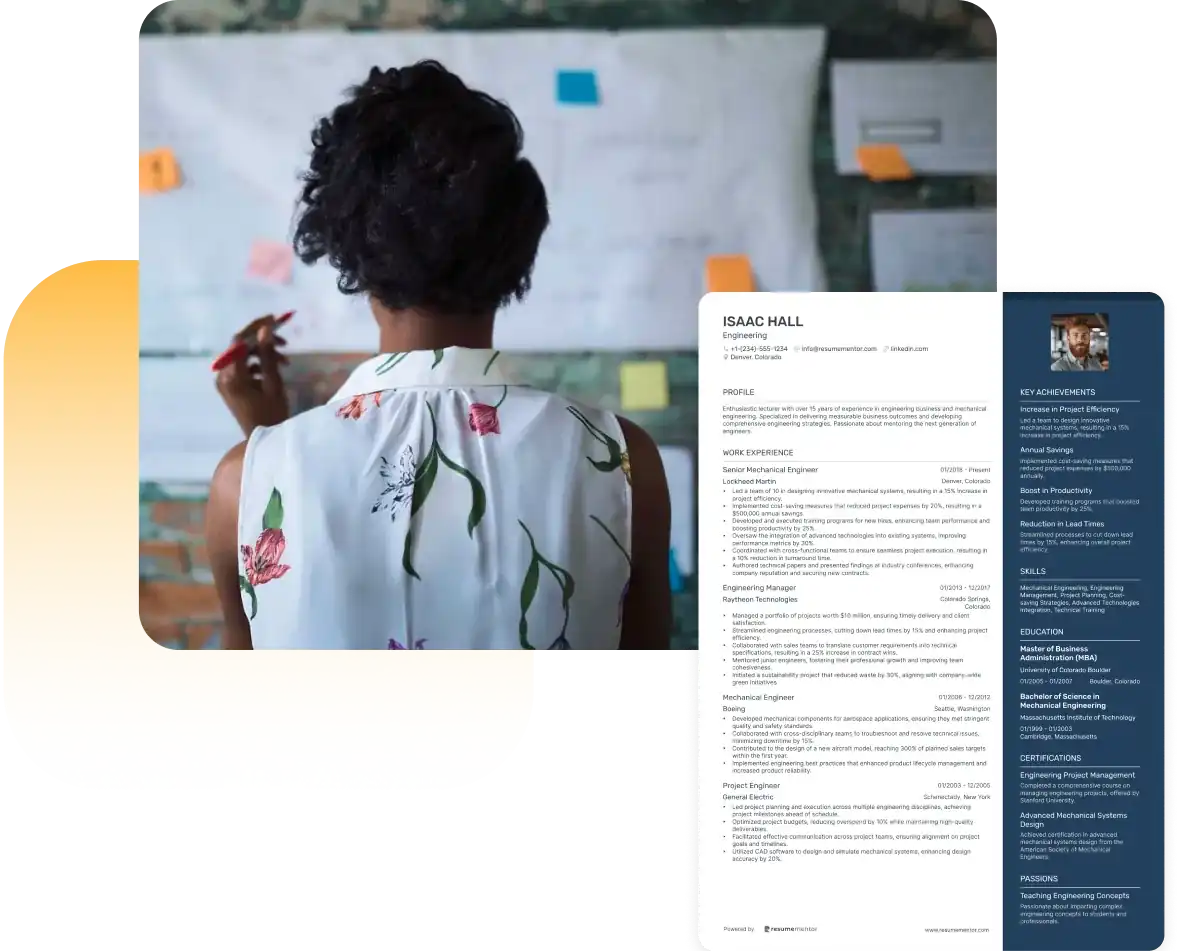
Continue Reading
Check more recommended readings to get the job of your dreams.
Resume
Resources
Tools
© 2025. All rights reserved.
Made with love by people who care.

